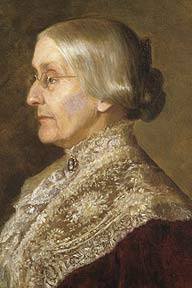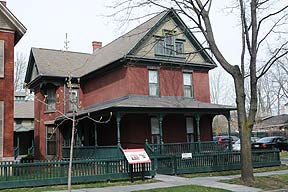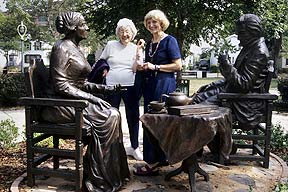Southwest Quadrant - Susan B. Anthony
 The Susan B. Anthony Neighborhood, named for legendary suffragist and abolitionist Susan Brownell Anthony, offers a culturally and economically diverse community with charming historic homes and nearby affordable rentals. The Neighborhood boundaries reach Allen Street on the north, east to Broad Street, south to West Main Street and west to Jefferson Avenue.
The Susan B. Anthony Neighborhood, named for legendary suffragist and abolitionist Susan Brownell Anthony, offers a culturally and economically diverse community with charming historic homes and nearby affordable rentals. The Neighborhood boundaries reach Allen Street on the north, east to Broad Street, south to West Main Street and west to Jefferson Avenue.
The Landmark Society of Western New York describes it as “the only surviving example in the city of an early-nineteenth century tract development that retains its original public square and alley configuration, commercial strip and industrial area, as well as the majority of its residential buildings.”
Years before Anthony’s Quaker family moved into their home on Madison Street, the area was a great transportation hub for early Rochester. Nearby were two canals, the Erie and the Genesee Valley, the largest turning basin for the canal boats. Also nearby was the Tonawanda Railroad, Rochester’s first rail, which carried passenger trains to Batavia in 1837 and beyond to Buffalo in ensuing years.
During her political career, Anthony lived with her sister, Mary, who later became the first female principal of a Rochester City School, Ward School #2 in 1868. Their family home and a house next door now make up the National Historic Landmark Susan B. Anthony House Museum and Visitor’s Center on Madison Street, which attracts visitors from around the world.
 The legacy of Frederick Douglass, escaped slave, abolitionist leader and statesman, looms large over the neighborhood. He was a close friend and political ally of Anthony during his time in Rochester. Their friendship and work together for civil rights for women and African Americans is honored in a bronze statue, “Let’s Have Tea,” which depicts the two historical giants in conversation. The statue was created by Rochester artist Pepsy Kettavong and installed in 2001.
The legacy of Frederick Douglass, escaped slave, abolitionist leader and statesman, looms large over the neighborhood. He was a close friend and political ally of Anthony during his time in Rochester. Their friendship and work together for civil rights for women and African Americans is honored in a bronze statue, “Let’s Have Tea,” which depicts the two historical giants in conversation. The statue was created by Rochester artist Pepsy Kettavong and installed in 2001.
Adjacent to the Square is the Frederick Douglass Resource Center on King Street. The Center is open by appointment and offers information on Douglass’ life and legacy for tourists, educators and students.
“A bronze voting box sculpture, the “1872 Monument”, created by sculpture Pepsy Kettavong marks the location where Susan B. Anthony and 14 other women voted in the 1872 presidential election. The sculpture was unveiled on August 22, 2009 on the 89th anniversary of the ratification of the 19th amendment to the U.S. Constitution. The monument can be found opposite Canal Street at 439 West Main Street, and will receive further enhancements under the W. Main Street to Troup Street Trail project, including benches, trees, and planting, this work is scheduled for the summer or 2012.”
 History is still fun for current residents. Every year, the neighborhood association organizes a Juneteenth celebration in Susan B. Anthony Square. This day commemorates June 19, 1865, a date when the abolition of slavery was announced in Texas, some three years after the Emancipation Proclamation. The all-day family festival features music and food. It attracts visitors of all ethnic backgrounds from throughout the city. In August 2010, the Neighborhood Association will celebrate its annual 19th Amendment Festival in the Square.
History is still fun for current residents. Every year, the neighborhood association organizes a Juneteenth celebration in Susan B. Anthony Square. This day commemorates June 19, 1865, a date when the abolition of slavery was announced in Texas, some three years after the Emancipation Proclamation. The all-day family festival features music and food. It attracts visitors of all ethnic backgrounds from throughout the city. In August 2010, the Neighborhood Association will celebrate its annual 19th Amendment Festival in the Square.
Additional Information
If you would like additional information on this neighborhood, please contact the Southwest Quadrant Neighborhood Service Center:
923 Genesee Street
Rochester, NY 14611
(585) 428-7630
Email: Charles.Reaves@CityofRochester.Gov